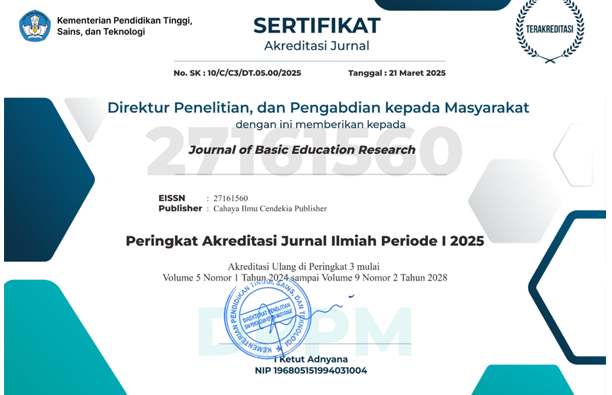Cross Language Sight Word Recognition of Multilingual Learners
Abstract
Purpose of the study: This study explores the most frequently encountered sight words among multilingual learners in early education. It aims to compare their recognition skills across three languages—first language, national language, and English—highlighting the complexities of sight word acquisition in multilingual settings and addressing a gap in existing research.
Methodology: This study employed a cross-language explanatory sequential design to examine sight word recognition among multilingual learners, specifically Ilokano speakers in the Philippines, where multilingualism is common. Most Filipinos speak at least two languages: their first language, along with Filipino (the national language) and English, which are used in formal education, government, and media. This multilingual context presents unique challenges in sight word recognition, as learners encounter sight words across these three languages. The study analyzed the frequency of sight word occurrence in educational materials and assessed recognition abilities in Ilokano, Tagalog, and English.
Main Findings: The data shows that sight word recognition improves across grades, initially varying by language but converging by Grade 3. Multilingual learners' recognition rates differ based on their language background, with early proficiency in certain languages impacting initial recognition. As learners progress, proficiency in one language influences others, explaining differences in Grade 1 and Grade 2 performance. By Grade 3, recognition rates converge, reflecting research that suggests multilingual learners achieve similar proficiency levels across languages over time.
References
C. J. Lonigan and B. M. Phillips, “Understanding the contributions of early academic skills to children's success in school,” in Contemporary Debates in Childhood Education and Development, S. Suggate and E. Reese, Eds., 1st ed. London, U.K.: Routledge, 2012. doi:10.4324/9780203115558
N. D. Amalia, “The importance of sight word recognition to improve reading fluency,” JELP Journal of English Language and Pedagogy, vol. 1, no. 2, pp. 102–115, 2022. doi:10.58518/jelp.v1i2.978
W. Duyck, E. Van Assche, D. Drieghe, and R. J. Hartsuiker, "Visual word recognition by bilinguals in a sentence context: Evidence for nonselective lexical access," Journal of Experimental Psychology: Learning, Memory, and Cognition, vol. 33, no. 4, pp. 663–679, 2007. doi:10.1037/0278-7393.33.4.663.
E. W. Dolch, "Problems in reading," The Elementary School Journal, vol. 48, no. 5, pp. 301-305, 1948.
L. Hutchison, S. Jerasa, R. Ahmmed, and E. Holcomb, "Reexamining the dolch basic sight word list: contemporary considerations for culturally sustaining approaches to assess sight word development," literacy research and instruction, pp. 1–23, 2024. doi:10.1080/19388071.2024.2321209
M. Snowling and C. Hulme, The science of reading: a handbook, european psychologist, vol. 11, pp. 1-661, 2005. https://onlinelibrary.wiley.com/doi/book/10.1002/9780470757642.
I. L. Beck and M. G. McKeown, "Increasing young low‐income children’s oral vocabulary repertoires through rich and focused instruction," The Elementary School Journal, vol. 107, no. 3, pp. 251-271, 2006. 10.1086/511706.
A. Bibi and J. Pujari, "Teaching sight-words to enhance word recognition and reading fluency of students with specific learning disabilities at the primary level," MIER Journal of Educational Studies Trends & Practices, pp. 336-355, 2023. https://doi.org/10.52634/mier/2023/v13/i2/2444.
E. Fry, "The new instant word list," The Reading Teacher, vol. 34, no. 3, pp. 284–289, 1980.
F. Genesee, Dual language development and disorders: A handbook on bilingualism and second language learning. Baltimore, MD: Brookes Publishing Co., 2008.
E. Hoff, Language Development. Boston, MA: Cengage Learning, 2013.
J. W. Creswell and J. D. Creswell, Research design: Qualitative, quantitative, and mixed methods approaches, 5th ed., Los Angeles, CA: SAGE Publications, Inc., 2018, pp. 213-246.
L. M. Justice and K. L. Pence, A Guide for Enhancing Young Children’s Language and Literacy Achievement. Newark, DE: International Reading Association, 2005.
H. Konishi, N. Brezack, R. M. Golinkoff, and K. Hirsh-Pasek, "Crossing to the other side: Language influences children’s perception of event components," Cognition, vol. 192, p. 104020, 2019.
E. Bialystok and F. I. Craik, "How does bilingualism modify cognitive function? Attention to the mechanism," Psychonomic Bulletin & Review, vol. 29, no. 4, pp. 1246–1269, 2022. doi:10.3758/s13423-022-02057-5.
J. Salminen, D. Khanolainen, T. Koponen, M. Torppa, and M. Lerkkanen, "Development of numeracy and literacy skills in early childhood—A longitudinal study on the roles of home environment and familial risk for reading and math difficulties," Frontiers in Education, vol. 6, 2021. doi:10.3389/feduc.2021.725337.
N. A. Puspitasari, V. S. Damaianti, S. Syihabuddin, and S. Sumiyadi, "The role of narrative ability on emergent literacy skills and early word reading of early childhood students," International Journal of Learning, Teaching and Educational Research, Aug. 30, 2023.
E. Geva, "The role of conjunctions in L2 text comprehension," TESOL Quarterly, vol. 26, no. 4, p. 731, 1992. doi:10.2307/3586871.
A. Jurkic, S. E. Halliday, and T. Hascher, "The relationship of language and social competence of preschool- and kindergarten-age single and dual language learners in Switzerland and Germany," Early Childhood Research Quarterly, vol. 64, pp. 72–83, 2023. doi:10.1016/j.ecresq.2023.02.003.
H. Ayana, T. Mereba, and A. Alemu, "Effect of vocabulary learning strategies on students’ vocabulary knowledge achievement and motivation: the case of grade 11 high school students," Frontiers in Education, vol. 9, 2024. Available: https://doi.org/10.3389/feduc.2024.1399350.
B. Bosch, "The Impact of Social/Emotional Learning in the Classroom for Young Children," 2023. https://repository.stcloudstate.edu/cfs_etds/49/.
E. Cárdenas-Hagan, C. Carlson, and S. Pollard-Durodola, "The Cross-Linguistic Transfer of Early Literacy Skills: The Role of Initial L1 and L2 Skills and Language of Instruction," Language, Speech, and Hearing Services in Schools, vol. 38, no. 3, 2007. doi:10.1044/0161-1461%282007/026%29.
J. Cummins, Language, Power and Pedagogy: Bilingual Children in the Crossfire, 1st ed. London: Multilingual Matters, 2000.
H. Pinnock and G. Vijayakumar, Language and Education: The Missing Link, Save the Children/UNESCO, 2009.
S. L. Walter and D. E. Dekker, “Mother tongue instruction in Lubuagan: A case study from the Philippines,” Int. Rev. Educ., vol. 57, no. 5–6, pp. 667–683, 2011.
A. Briceño, "Language transfer in a dual immersion program: cognates, morphology and language contrasts," NABE Journal of Research and Practice, vol. 8, no. 1, pp. 111–132, 2017. doi:10.1080/26390043.2017.12067799.
A. Mahboob and P. Cruz, "English and mother-tongue-based multilingual education: Language attitudes in the Philippines," Asian Journal of English Language Studies, vol. 1, pp. 1–17, 2013. doi:10.59960/1.a1.
O. García, “Multilingualism and Language Education,” in The Routledge Companion to English Studies, C. Leung and B. V. Street, Eds., 1st ed., London: Routledge, 2014. doi: 10.4324/9781315852515
F. Herrera and R. Luzon, “Best practices in developing reading proficiency in the mother tongue among public schools in Butuan City, Philippines,” J. Acad. Soc. Sci. Hum. & Educ., vol. 2, no. 1, pp. 97–104, 2016.
A. Lopez and M. Lopez, “The impact of mother tongue-based reading instruction on the literary comprehension of Grade 3 pupils,” Asia Pacific Journal of Educational Research, vol. 5, no. 3, pp. 123–135, 2016.
X. Jiang, "The role of first language literacy and second language proficiency in second language reading comprehension," The Reading Matrix, vol. 11, no. 2, 2011.
R. Filippi, A. Ceccolini, R. C. Perry, and M. S. C. Thomas, “The impact of multilingualism and socio-economic status on academic performance: evidence from the SCAMP and the national pupil databases,” Int. J. Biling. Educ. Biling., vol. 28, no. 1, pp. 53–72, 2024. doi:10.1080/13670050.2024.2397445.
UNESCO, “Multilingual education: Key to quality and inclusive learning,” UNESCO, 2021.
Center for Applied Linguistics, “Multilingual learners and academic literacies,” Center for Applied Linguistics, 2020.
B. William, A. Magalong, and R. Dizon, “The effect of bilingual education programs on literacy skills in Philippine elementary schools,” J. Educ. Res. Develop., vol. 32, no. 1, pp. 45–59, 2025.
F. Abocejo, “Evaluation of the Mother Tongue-Based Multilingual Education (MTB-MLE) program in the Philippines,” J. Multilingual Educ. Res., vol. 15, pp. 78–92, 2022.
Copyright (c) 2025 Leonardo Tejano

This work is licensed under a Creative Commons Attribution 4.0 International License.
Authors who publish with this journal agree to the following terms:
- Authors retain copyright and acknowledge that the Journal of Basic Education Research is the first publisher licensed under a Creative Commons Attribution 4.0 International License.
- Authors are able to enter into separate, additional contractual arrangements for the non-exclusive distribution of the journal's published version of the work (e.g., post it to an institutional repository or publish it in a book), with an acknowledgment of its initial publication in this journal.
- Authors are permitted and encouraged to post their work online (e.g., in institutional repositories or on their website) prior to and during the submission process, as it can lead to productive exchanges and earlier and greater citation of published work.





.png)


.png)
.png)


















